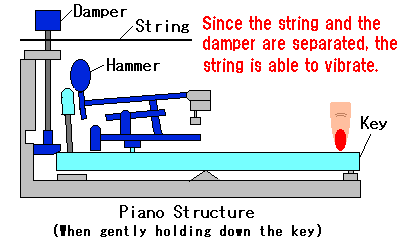 Instrument Tricks
Instrument Tricks

The key that's not being struck, is heard?!

When playing the piano, is it possible to have the sound of the key being played and the actual sound being emitted to be different? It certainly can. The main factor that causes this lies in the piano's structure (For those who want to see a more detailed description of the piano's structure, click here).
A particular key is gently held down.
Because the hammer doesn't strike the string, no sound is emitted.
Then, since the string and the damper are now separated, the string is able to vibrate.
In this situation, an overtone of the original key (currently being held down) is quickly struck (staccato).
Therefore, the key that was originally being held down is finally heard moments after the overtone's key is heard.
The oscillation of the second key stops when that key is released. The oscillation of the second key will cause the string of the original key to resonate, enabling the above situation to occur.
For example...

The C4 key (261.63Hz) is gently held down. "Gently", so as not to actually hear the note.
In this situation, the C3 key (130.81Hz), one octave under the C4 key (twice the frequency as C3), is quickly struck.
Then, the C4 key's string is continually resonated by the C3 string's oscillation.
For example, similarly, when the G4 key (392.00Hz), or C5 key (523.35Hz) (three times and four times the frequency of C3 respectively) are gently held down, and the C3 key is again quickly struck, the same effect is achieved.
The C4 key (261.63Hz) is gently held down and the C3 key (130.81Hz) is quickly struck.

wmv(46kb)
The G4 key (392.00Hz) is gently held down and the C3 key (130.81Hz) is quickly struck.

wmv(42kb)
The C4 (261.63Hz), E4 (329.63Hz), and G4 keys (392.00Hz) are gently held down and the C3 key (130.81Hz) is quickly struck.

wmv(42kb)



 Instrument Tricks
Instrument Tricks





